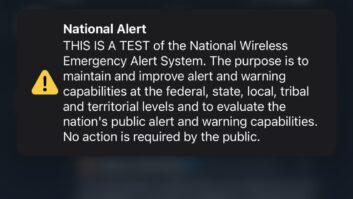It seems almost everyone has something to say about the nation’s wireless emergency alerting infrastructure — the city of San Francisco, emergency reps from California wine country, the New York City chief of police, even Microsoft.
Recent news events have made the topic more pressing. But the praise and concerns mentioned here were shared in formal comments filed to the FCC as it plans to consider changes next week to the Wireless Emergency Alert system and amend Part 11 of the rules regarding the Emergency Alert System.
The orders that the commission is considering in Docket 15-91 are designed to enhance the effectiveness of WEA, the FCC has said, including improving the geographic accuracy of WEA alerts.
James O’Neill, police commissioner for New York City, was an early filer of comments to the FCC ECFS database. He described an incident in September 2016 in which the NYPD requested that the Office of Emergency Management send a Wireless Emergency Alert to every phone in all five boroughs to apprehend a 28-year-old male wanted as part of a counterterrorism operation. The alert went out, but due to “outmoded restrictions,” O’Neill said, the department couldn’t add an image into the alert. “Instead we had to … hope [the public] would take the additional steps to search the internet on their own,” he wrote.
“The law enforcement community can no longer afford to depend on an emergency wireless response system that is lagging far behind what technology can offer,” he said.
The NYPD also called on the FCC to increase the character count in WEA messages from 90 to 360 characters, include URLs and telephone numbers in WEA messages, and adopt Spanish-language messaging.
O’Neill was one of several commenters that called on the FCC to improve the geotargeting aspects of WEA alerts. The Board of Supervisors in Sonoma County in California also urged the commission to create an emergency alert system by May 2019 that will require wireless carriers to support geotargeting within one-tenth of a mile.
“These changes are necessary to make this tool useful for life-saving emergency notifications in geographically diverse urban and rural areas,” wrote Board Chair Shirlee Zane.
A similar assessment came from a number of emergency agencies in Oregon and Washington, who called on the FCC to require major cell carriers to deliver an alert message to 100% of a target area with no more than a 0.1 of a mile overshoot. This is a proposal that has been championed by FCC Chairman Ajit Pai. However, the emergency agencies chided the commission for not offering detailed definitions of how intelligence in a handset will be incorporated into WEA and how wireless providers will be required to enact the proposed WEA changes. The groups — which included emergency agencies in Portland, Multnomah County, Clackamas Country and Columbia County — also urged the FCC to set a specific implementation timeline.
That deadline needs to be May 2019, the agencies said. “We urge the FCC to act swiftly to meet the need for enhanced WEA geo‐targeting capabilities no later than May 2019, the same timeframe set for the previously approved WEA upgrades to rollout,” the agencies said in their joint filing.
Comments can be submitted at the FCC ECFS database using Docket 15-92.











